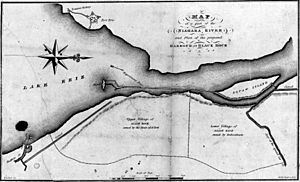Unity Island facts for kids
Unity Island is a large island, about 160 acres (0.65 square kilometers) in size. It sits between the Niagara River and the Black Rock Canal, right inside Buffalo, New York. This historic island has two public parks and a special building that cleans water. A swing bridge connects it to the mainland.
The island's first name, given by the Seneca people, was Deyowenoguhdoh. For a long time, from the early 1800s until 2015, it was also called Squaw Island. In June 2015, people like Jodi Lynn Maracle (a Mohawk resident) and members of the Seneca Nation of New York asked for the name to be changed. They felt the name was disrespectful to Native American women. The Buffalo Common Council agreed and voted to change the name to Unity Island. The new name became official in October 2015, and new signs were put up. The U.S. Board on Geographic Names officially recognized the name in May 2017.
Discover Unity Island
A Look Back: Island History
Early Days and Names
The Seneca people first owned Unity Island and the land around it in the 1650s. They called it Deyowenoguhdoh, which means "divided island." This name came from a small marshy creek that once ran through the island. The name Squaw Island appeared before the War of 1812, but no one knows exactly how it started.
The island stayed with the Seneca Nation until the early 1800s. Philip Kenjockety, one of the last people from the Neutral Nation, had a cornfield on the island. He died in 1808. Kenjockety used to travel by canoe on the creek that divided the island when he went to and from Canada.
The War of 1812: HMS Detroit
On October 9, 1812, a British ship called HMS Detroit got stuck on Unity Island. This happened during the War of 1812. The ship was captured by American forces near Fort Erie. Light winds and strong currents made it hard for the Americans to move the ship away from British cannons. After a lot of fighting, the ship was left to the river. It ended up on the island, where both British and American cannons could reach it. Both sides fought over the stuck ship until American forces set it on fire and burned it.
Changing Hands
Unity Island remained with the Seneca people until 1816. They gave the land to Captain Jasper Parrish. This was a gift for his help as their agent and interpreter. Later, in 1823, Parrish sold the island to a local lawyer named Henry F. Penfield.
What's on the Island Today?
In later years, Unity Island became public property. The northern part of the island was once used as a landfill. This area was later covered up and turned into the beautiful Unity Island Park we see today. A special building that cleans water for the City of Buffalo started working on the island in 1938. Building this facility actually made the island a little bigger.
Broderick Park: A Path to Freedom
At the very southern tip of Unity Island is Broderick Park. This spot was once home to the Black Rock ferry. This ferry was a very important way to cross the Niagara River between Buffalo and Fort Erie, Ontario. The ferry ran from 1825 until the mid-1900s.
The ferry's dock on the western side of the park was a secret stop on the Underground Railroad. This was a network of safe places that helped enslaved people escape to freedom. From at least the 1830s until the American Civil War, people escaping slavery would arrive at Broderick Park. From here, they would take the ferry or other boats across the Niagara River to Canada, where they could finally be free.
The Story of Bird Island
A long, narrow stone wall called Bird Island Pier extends from the southern end of Unity Island. This pier was finished in 1860. It used to connect Unity Island to a small piece of land called Bird Island. Bird Island had rocky parts and fertile soil. Philip Kenjockety's father grew corn there.
DeWitt Clinton, who helped plan the Erie Canal, wrote about Bird Island in his journal. An old map from 1829 shows the planned Bird Island Pier connecting Unity Island to Bird Island. However, by 1880, Bird Island was gone. The rocks from Bird Island were used to build the Black Rock Pier, which helped support the Erie Canal.



